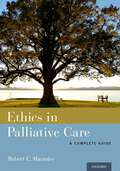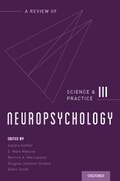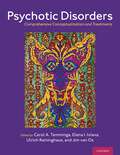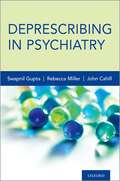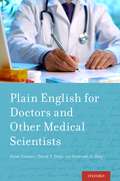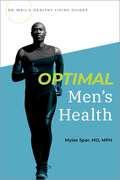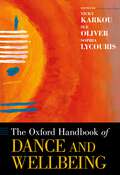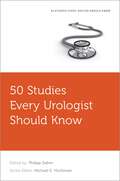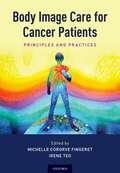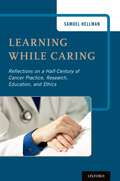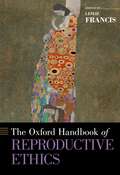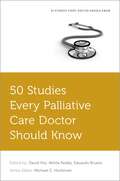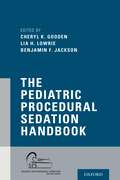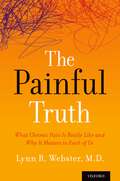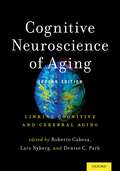- Table View
- List View
Ethics in Palliative Care: A Complete Guide
by Robert C. MacauleyNo specialty faces more diverse and challenging ethical dilemmas than palliative medicine. What is the best way to plan ahead for the end of life? How should physicians respond when patients refuse treatments likely to be beneficial, or demand treatments not likely to be? Who makes medical decisions for patients who are too ill to decide for themselves? Do patients have the "right to die" (and, if so, what exactly does that mean)? In this volume noted palliative care physician and bioethicist Robert C. Macauley addresses a broad range of issues from historical, legal, clinical, and ethical perspectives. Clinically nuanced and philosophically rigorous, Ethics in Palliative Care analyzes hot-button subjects like physician assisted dying and euthanasia, as well as often overlooked topics such as pediatric palliative care, organ donation, palliative care research, and moral distress. Drawing on real cases yet written in non-technical language, this complete guide will appeal to both medical professionals and lay readers.
Neuropsychology: Science and Practice
Compiled reviews of the recent literature are a long established tradition in the laboratory and clinical sciences, and bring to their professions a useful and timely summary of the advances that have been made in the field. Neuropsychology has matured as a science and profession to support a like effort to summarize, across domains, the direction and momentum in the field. The authors are authorities in the subjects they review and provide for the investigator, practitioner and student an overview of the important developments in neuropsychology that cannot be realized from perusal of the journals alone. Interest in the reviews are likely to go beyond the discipline of neuropsychology, and will extend to all with an interest in science of brain-behavior relationships, in the study of disease and injury as they affect brain function, and in the rehabilitation of the individual who has suffered insult to brain. Chapters cover the pragmatic application of tests and test findings to improve our understanding of the behavior of individuals who present with neurocognitive disorders. Where there is interest in efficiently acquiring a sound perspective of the important advances and the future direction of neuropsychology, Neuropsychology: A Review of Science and Practice will provide the means for so doing as no other publication can offer.
Neuropsychology: Science and Practice
by Sandra Koffler, E. Mark Mahone, Bernice A. Marcopulos, Douglas Johnson-Greene, and Glenn SmithCompiled reviews of the recent literature are a long established tradition in the laboratory and clinical sciences, and bring to their professions a useful and timely summary of the advances that have been made in the field. Neuropsychology has matured as a science and profession to support a like effort to summarize, across domains, the direction and momentum in the field. The authors are authorities in the subjects they review and provide for the investigator, practitioner and student an overview of the important developments in neuropsychology that cannot be realized from perusal of the journals alone. Interest in the reviews are likely to go beyond the discipline of neuropsychology, and will extend to all with an interest in science of brain-behavior relationships, in the study of disease and injury as they affect brain function, and in the rehabilitation of the individual who has suffered insult to brain. Chapters cover the pragmatic application of tests and test findings to improve our understanding of the behavior of individuals who present with neurocognitive disorders. Where there is interest in efficiently acquiring a sound perspective of the important advances and the future direction of neuropsychology, Neuropsychology: A Review of Science and Practice will provide the means for so doing as no other publication can offer.
Psychotic Disorders: Comprehensive Conceptualization and Treatments
Psychotic Disorders: Comprehensive Conceptualization and Treatments emphasizes a dimensional approach to psychosis--one of the most fascinating manifestations of altered brain behavior--that cuts across a broad array of psychiatric diagnoses from schizophrenia to affective psychosis and organic disorders like epilepsy and dementias. Written by an international roster of over seventy leading experts in the field, this volume comprehensively reviews, critiques, and integrates available knowledge on the etiology, mechanisms, and treatments of psychotic disorders, and outlines ways forward in both research and clinical practice towards more objective, mechanistically-based definitions of psychotic disorders. Chapters address topics such as psychosis phenomenology, biomarkers and treatments, the overlaps and interfaces between psychiatric disorders within the psychosis dimension, and novel disease definitions. Furthermore, the volume incorporates findings on potential mechanisms, bridges between various system levels (i.e., genetic, epigenetic, molecular and cellular, brain circuit and function, psychological, social, environmental and cultural) and their interactions, as well as the potential role in causation and/or mediation in psychotic disorders. Finally, the volume outlines a broad array of treatment approaches, from the readily available (e.g., psychopharmacology, various modalities of psychotherapy) to the experimental (e.g., cognitive interventions, neuromodulation). With a concluding section of forward perspectives conjecturing future directions and related challenges, this book aspires to stimulate new knowledge, generate novel frameworks, and carry new directions forward on psychotic disorders.
Deprescribing in Psychiatry
by Swapnil Gupta John Cahill Rebecca MillerThe current state of medicine has witnessed the long-term adverse effects of certain medications, an increased rate of polypharmacy, and a cultural shift that emphasizes patient-centered practice. The term "deprescribing" refers to the optimization of the pharmacological regimen by reducing or cessing medications that incur more risks than benefits. Many people consider stopping their psychiatric medications, but prescribers may not know how to do this in a collaborative, systematic way. Deprescribing in Psychiatry presents a framework for deprescribing to guide the prescriber-patient dyad through the process of deciding if and when to reduce psychiatric medication, how to go about doing it, and at the same time, acknowledge the inherent risks in such an endeavour. As the first book on the subject, Deprescribing in Psychiatry stands to serve as a definitive text in this burgeoning field and as a 'rallying call' to raise crucial and topical questions in psychiatric practice, promote innovation, and act as a resource on the current state-of-the-art care. It describes the ins and outs of how clinicians can work closely with their patients to consider whether or not to try decreasing medications. It also discusses the anticipated future research directions, considerations for the field, and emphasizes collaboration with the patient, transparency, and the acknowledgement of uncertainty in psychiatric practice.
Deprescribing in Psychiatry
by Rebecca Miller John Cahill Swapnil GuptaThe current state of medicine has witnessed the long-term adverse effects of certain medications, an increased rate of polypharmacy, and a cultural shift that emphasizes patient-centered practice. The term "deprescribing" refers to the optimization of the pharmacological regimen by reducing or cessing medications that incur more risks than benefits. Many people consider stopping their psychiatric medications, but prescribers may not know how to do this in a collaborative, systematic way. Deprescribing in Psychiatry presents a framework for deprescribing to guide the prescriber-patient dyad through the process of deciding if and when to reduce psychiatric medication, how to go about doing it, and at the same time, acknowledge the inherent risks in such an endeavour. As the first book on the subject, Deprescribing in Psychiatry stands to serve as a definitive text in this burgeoning field and as a 'rallying call' to raise crucial and topical questions in psychiatric practice, promote innovation, and act as a resource on the current state-of-the-art care. It describes the ins and outs of how clinicians can work closely with their patients to consider whether or not to try decreasing medications. It also discusses the anticipated future research directions, considerations for the field, and emphasizes collaboration with the patient, transparency, and the acknowledgement of uncertainty in psychiatric practice.
Plain English for Doctors and Other Medical Scientists
by Oscar Linares David Daly Gertrude DalyPlain English for Doctors shows how to write about medical science in a clear and vivid way. It can help a medical writer at any level, from beginner to veteran, since it gives specific, practical advice. Writing in plain English can help your writing reach a wider audience, including people in other specialties, levels of training, other fields, and other countries around the world. What makes medical writing hard to read? Is it complex science or complex grammar? This book shows how to keep good science but avoid complex grammar. It describes the symptoms of medicus incomprehensibilis, those over-used writing habits that tend to make medical writing hard to read. It shows how to treat each symptom using a proven plain English writing tip. Each tip is easy to apply and comes with exercises. The exercises are based on excerpts from articles published in leading medical journals. Model revisions vastly improve reading ease and grade level. The book looks at medical writing from three angles. Concept 1, Take charge of your reading ease score, shows how to manage reading ease. Concept 2, Write vividly, shows how to write more vividly by focusing on real world objects and actions. Concept 3, Present logical reasoning clearly, gives tips on how to choose a clear narrative pathway and forge a strong chain of logical reasoning. This book is a must for anyone who writes about medical science. The ability to express complex ideas in simple language is not a remedial skill. Rather, it can only be seen as a sign of mastery.
Plain English for Doctors and Other Medical Scientists
by David Daly Oscar Linares Gertrude DalyPlain English for Doctors shows how to write about medical science in a clear and vivid way. It can help a medical writer at any level, from beginner to veteran, since it gives specific, practical advice. Writing in plain English can help your writing reach a wider audience, including people in other specialties, levels of training, other fields, and other countries around the world. What makes medical writing hard to read? Is it complex science or complex grammar? This book shows how to keep good science but avoid complex grammar. It describes the symptoms of medicus incomprehensibilis, those over-used writing habits that tend to make medical writing hard to read. It shows how to treat each symptom using a proven plain English writing tip. Each tip is easy to apply and comes with exercises. The exercises are based on excerpts from articles published in leading medical journals. Model revisions vastly improve reading ease and grade level. The book looks at medical writing from three angles. Concept 1, Take charge of your reading ease score, shows how to manage reading ease. Concept 2, Write vividly, shows how to write more vividly by focusing on real world objects and actions. Concept 3, Present logical reasoning clearly, gives tips on how to choose a clear narrative pathway and forge a strong chain of logical reasoning. This book is a must for anyone who writes about medical science. The ability to express complex ideas in simple language is not a remedial skill. Rather, it can only be seen as a sign of mastery.
Optimal Men's Health (Dr Weils Healthy Living Guides)
by Myles SparOptimal Men's Health is a comprehensive yet easy-to-understand guide to everything men (and the women who care about them) need to know about health. Taking an integrative approach, Dr. Myles Spar shows you how to feel young and powerful at any age while minimizing the risk of disease, showing that prevention is just as important as treatment. This curated content gives the reader easy recommendations for what tests you should look for in order to know your risks for future health problems and what you can do, beyond taking medications, to prevent those problems from getting in your way or for treating any chronic conditions. Using science-based information, this book asks the reader, "What do you want your health for?" and then sets out to equip them with all that they needs to make sure their health will facilitate, and not hinder, the reader's life goals. Using real patient experience, Dr. Spar explains the usefulness of advanced testing; the usefulness of integrative medicine approaches such as mindfulness, an anti-inflammatory diet, how to optimize sleep, and the use of supplements for all of the conditions; and uses various complementary treatments and therapies that can be useful in preventing and treating diseases through acupuncture, yoga, exercise, and more. Dr. Spar provides you with lists of questions to ask your healthcare professional, sidebars of key information, checklists and action plans, lists of resources and suggested further reading for you to take your health journey into your own hands. Optimal Men's Health equips you to achieve your health goals, addressing every aspect of lifestyle, medicine, and alternative therapies. This is the perfect resource for anyone, man or woman, to live your best life.
Optimal Men's Health (Dr Weils Healthy Living Guides)
by Myles SparOptimal Men's Health is a comprehensive yet easy-to-understand guide to everything men (and the women who care about them) need to know about health. Taking an integrative approach, Dr. Myles Spar shows you how to feel young and powerful at any age while minimizing the risk of disease, showing that prevention is just as important as treatment. This curated content gives the reader easy recommendations for what tests you should look for in order to know your risks for future health problems and what you can do, beyond taking medications, to prevent those problems from getting in your way or for treating any chronic conditions. Using science-based information, this book asks the reader, "What do you want your health for?" and then sets out to equip them with all that they needs to make sure their health will facilitate, and not hinder, the reader's life goals. Using real patient experience, Dr. Spar explains the usefulness of advanced testing; the usefulness of integrative medicine approaches such as mindfulness, an anti-inflammatory diet, how to optimize sleep, and the use of supplements for all of the conditions; and uses various complementary treatments and therapies that can be useful in preventing and treating diseases through acupuncture, yoga, exercise, and more. Dr. Spar provides you with lists of questions to ask your healthcare professional, sidebars of key information, checklists and action plans, lists of resources and suggested further reading for you to take your health journey into your own hands. Optimal Men's Health equips you to achieve your health goals, addressing every aspect of lifestyle, medicine, and alternative therapies. This is the perfect resource for anyone, man or woman, to live your best life.
The Oxford Handbook of Dance and Wellbeing (Oxford Handbooks)
by Vicky Karkou, Sue Oliver and Sophia LycourisIn recent years, a growth in dance and wellbeing scholarship has resulted in new ways of thinking that place the body, movement, and dance in a central place with renewed significance for wellbeing. The Oxford Handbook of Dance and Wellbeing examines dance and related movement practices from the perspectives of neuroscience and health, community and education, and psychology and sociology to contribute towards an understanding of wellbeing, offer new insights into existing practices, and create a space where sufficient exchange is enabled. The handbook's research components include quantitative, qualitative, and arts-based research, covering diverse discourses, methodologies, and perspectives that add to the development of a complete picture of the topic. Throughout the handbook's wide-ranging chapters, the objective observations, felt experiences, and artistic explorations of practitioners interact with and are printed alongside academic chapters to establish an egalitarian and impactful exchange of ideas.
50 Studies Every Urologist Should Know (Fifty Studies Every Doctor Should Know)
50 Studies Every Urologist Should Know presents key studies that have shaped the practice of urology. Selected using a rigorous methodology, the studies cover topics including reflux disease in paediatric urology, management of male erectile dysfunction and lower urinary tract symptoms, female urology and stone disease, the various forms of genitourinary cancer, and more. For each study, a concise summary is presented with an emphasis on the results and limitations of the study, and its implications for practice. An illustrative clinical case concludes each review, followed by brief information on other relevant studies. This book is a must-read for healthcare professionals in urology, as well as anyone who wants to learn more about the data behind clinical practice.
50 Studies Every Urologist Should Know (Fifty Studies Every Doctor Should Know)
by Philipp Dahm50 Studies Every Urologist Should Know presents key studies that have shaped the practice of urology. Selected using a rigorous methodology, the studies cover topics including reflux disease in paediatric urology, management of male erectile dysfunction and lower urinary tract symptoms, female urology and stone disease, the various forms of genitourinary cancer, and more. For each study, a concise summary is presented with an emphasis on the results and limitations of the study, and its implications for practice. An illustrative clinical case concludes each review, followed by brief information on other relevant studies. This book is a must-read for healthcare professionals in urology, as well as anyone who wants to learn more about the data behind clinical practice.
Body Image Care for Cancer Patients: Principles and Practice
This book is the first and only academic textbook of principles and practices of body image care for cancer patients, designed to target a multidisciplinary audience of healthcare care professionals engaged in the science and/or practice of psychosocial oncology internationally. Content is primarily geared toward mental health professionals or those involved in supportive care of cancer patients, but is broadly applicable to all members of the oncologic healthcare team. Best practices and models of body image care are reviewed and presented in such a manner as to be directly relevant to oncologists, psychiatrists, psychologists, nurses, social workers, rehabilitation specialists, speech and language pathologists, and other allied healthcare professionals. Body Image Care for Cancer Patients provides a 7omprehensive overview of available literature on body image outcomes with cancer populations, and integrates scientific findings from the general body image literature that can be applied to the oncology setting. Readers are provided with a comprehensive theoretical foundation along with practical recommendations for assessment tools and intervention approaches that can be utilized by a range of healthcare professionals. Case examples are incorporated throughout the textbook considering different aspects of disease and treatment, and are written from the perspective of different professional disciplines. This book will be relevant for emerging as well as established healthcare professionals internationally, and can be used in training and other educational settings. This book is unique as there is no current academic text focusing on advancing the science and practice of body image care for cancer patients. Other reference texts have broadly focused on reviewing body image theory and findings in the general population or across a broad spectrum of medical illness. The time has come for a more focused textbook specific to body image and cancer that can significantly benefit the field of oncology.
Body Image Care for Cancer Patients: Principles and Practice
by Michelle Cororve Fingeret and Irene TeoThis book is the first and only academic textbook of principles and practices of body image care for cancer patients, designed to target a multidisciplinary audience of healthcare care professionals engaged in the science and/or practice of psychosocial oncology internationally. Content is primarily geared toward mental health professionals or those involved in supportive care of cancer patients, but is broadly applicable to all members of the oncologic healthcare team. Best practices and models of body image care are reviewed and presented in such a manner as to be directly relevant to oncologists, psychiatrists, psychologists, nurses, social workers, rehabilitation specialists, speech and language pathologists, and other allied healthcare professionals. Body Image Care for Cancer Patients provides a 7omprehensive overview of available literature on body image outcomes with cancer populations, and integrates scientific findings from the general body image literature that can be applied to the oncology setting. Readers are provided with a comprehensive theoretical foundation along with practical recommendations for assessment tools and intervention approaches that can be utilized by a range of healthcare professionals. Case examples are incorporated throughout the textbook considering different aspects of disease and treatment, and are written from the perspective of different professional disciplines. This book will be relevant for emerging as well as established healthcare professionals internationally, and can be used in training and other educational settings. This book is unique as there is no current academic text focusing on advancing the science and practice of body image care for cancer patients. Other reference texts have broadly focused on reviewing body image theory and findings in the general population or across a broad spectrum of medical illness. The time has come for a more focused textbook specific to body image and cancer that can significantly benefit the field of oncology.
Learning While Caring: Reflections on a Half-Century of Cancer Practice, Research, Education, and Ethics
by Samuel HellmanIn the last half century, a revolution in biology and medicine has taken place, bringing about emerging practical, philosophical, and societal issues with which academia in general, and medicine and oncology in particular, must grapple. One witness to this revolution is Samuel B. Hellman, a radiation oncologist who has served as Dean of the Pritzker School of Medicine at the University of Chicago; Physician-in-Chief at Memorial Sloan Kettering Cancer Center; Chair of Radiation Therapy at Harvard Medical School; President of the American Society of Clinical Oncology; President of the American Society of Therapeutic Radiology and Oncology; and co-editor with Dr. Vincent DeVita of seven editions of Cancer: Principles and Practice of Oncology, the premier oncology text in the world. Learning While Caring offers a collection of Dr. Hellman's essays and articles, in which he delves into the issues brought about by advances and changes in medicine over the last fifty years. The essays are organized into five sections: Medical Ethics and Learning; Academic Medicine; Research; Perceptions of Cancer; and Heroes. Each section is introduced by a new commentary from Dr. Hellman on the historical aspects and current significance of the issues presented in that section's essays. Throughout, Dr. Hellman interweaves reflections on major aspects of his professional career and the times in which they occurred as examples of the challenges and controversies that confront oncology, medicine, and academia. The book concludes with "Summing Up," reviewing changes in medical practice and biological science and concluding that, despite these huge changes, certain things remain the same, especially the primary obligation of the doctor to the patient and the need to seek and test new knowledge. Dr. Hellman writes, "We are currently at the end of the beginning of the revolution in biology and medicine resulting from the understanding of how genetic information was passed generationally. Our capacities are far greater now but the essence of medical practice and our responsibility to the patient remains the same."
Learning While Caring: Reflections on a Half-Century of Cancer Practice, Research, Education, and Ethics
by Samuel HellmanIn the last half century, a revolution in biology and medicine has taken place, bringing about emerging practical, philosophical, and societal issues with which academia in general, and medicine and oncology in particular, must grapple. One witness to this revolution is Samuel B. Hellman, a radiation oncologist who has served as Dean of the Pritzker School of Medicine at the University of Chicago; Physician-in-Chief at Memorial Sloan Kettering Cancer Center; Chair of Radiation Therapy at Harvard Medical School; President of the American Society of Clinical Oncology; President of the American Society of Therapeutic Radiology and Oncology; and co-editor with Dr. Vincent DeVita of seven editions of Cancer: Principles and Practice of Oncology, the premier oncology text in the world. Learning While Caring offers a collection of Dr. Hellman's essays and articles, in which he delves into the issues brought about by advances and changes in medicine over the last fifty years. The essays are organized into five sections: Medical Ethics and Learning; Academic Medicine; Research; Perceptions of Cancer; and Heroes. Each section is introduced by a new commentary from Dr. Hellman on the historical aspects and current significance of the issues presented in that section's essays. Throughout, Dr. Hellman interweaves reflections on major aspects of his professional career and the times in which they occurred as examples of the challenges and controversies that confront oncology, medicine, and academia. The book concludes with "Summing Up," reviewing changes in medical practice and biological science and concluding that, despite these huge changes, certain things remain the same, especially the primary obligation of the doctor to the patient and the need to seek and test new knowledge. Dr. Hellman writes, "We are currently at the end of the beginning of the revolution in biology and medicine resulting from the understanding of how genetic information was passed generationally. Our capacities are far greater now but the essence of medical practice and our responsibility to the patient remains the same."
The Oxford Handbook of Reproductive Ethics (Oxford Handbooks)
by Leslie FrancisIntimate and medicalized, natural and technological, reproduction poses some of the most challenging ethical dilemmas of our time. Reproduction presses the boundaries of humanity and ethical respect, the permissible limits of technology, conscientious objection by health care professionals, and social justice. This volume brings together scholars from multiple perspectives to address both traditional and novel questions about the rights and responsibilities of human reproducers, their caregivers, and the societies in which they live. Among issues treated in the volume are what it is to be a parent, the responsibilities of parents, and the role of society in facilitating or discouraging parenting. May gamete donors be anonymous? Is surrogacy in which a woman gestates a child for others ethically permissible when efforts are made to prevent coercion or exploitation? Should it be mandatory to screen newborns for potentially serious conditions, or permissible to sequence their genomes? Are both parties to a reproductive act equally responsible to support the child, even if one deceived the other? Are there ethical asymmetries between male and female parents, and is the lack of available contraceptives for men unjust? Should the costs of infertility treatment be socially shared, as they are for other forms of health care? Do parents have a duty to try to conceive children under the best circumstances they can-or to avoid conception if the child will suffer? What is the status of the fetus and what ethical limits constrain the use of fetal tissue? Reproduction is a rapidly changing medical field, with novel developments such as mitochondrial transfer or uterine transplantation occurring regularly. And there are emerging natural challenges, too, with Zika virus just the latest. The volume gives readers tools not only to address the problems we now know, but ones that may emerge in the future as well.
50 Studies Every Palliative Care Doctor Should Know (Fifty Studies Every Doctor Should Know)
by David Hui Akhila Reddy Eduardo Bruera50 Studies Every Palliative Doctor Should Know presents key studies that have shaped the practice of palliative medicine. Selected using a rigorous methodology, the studies cover topics including: palliative care, symptom assessment and management, psychosocial aspects of care and communication, and end-of-life care. For each study, a concise summary is presented with an emphasis on the results and limitations of the study, and its implications for practice. An illustrative clinical case concludes each review, followed by brief information on other relevant studies. This book is a must-read for health care professionals and anyone who wants to learn more about the data behind clinical practice.
50 Studies Every Palliative Care Doctor Should Know (Fifty Studies Every Doctor Should Know)
by Eduardo Bruera David Hui Akhila Reddy50 Studies Every Palliative Doctor Should Know presents key studies that have shaped the practice of palliative medicine. Selected using a rigorous methodology, the studies cover topics including: palliative care, symptom assessment and management, psychosocial aspects of care and communication, and end-of-life care. For each study, a concise summary is presented with an emphasis on the results and limitations of the study, and its implications for practice. An illustrative clinical case concludes each review, followed by brief information on other relevant studies. This book is a must-read for health care professionals and anyone who wants to learn more about the data behind clinical practice.
The Pediatric Procedural Sedation Handbook
The Pediatric Procedural Sedation Handbook provides a comprehensive but concise review of the essential information needed to allow for the safe practice of pediatric procedural sedation. Written by a group of multidisciplinary authors, this text explores the fundamentals of sedation, procedural sedation, special patient considerations, diagnostic and therapeutic procedures, and more. Each chapter offers a starting point and suggestions for further in-depth study of all aspects of providing safe, effective, multidisciplinary-team based sedation care for children undergoing testing and procedures outside of an operating room setting. Appendices providing medication dosing and delivery route suggestions complement the text and can be used for quick reference. This book is a must-read for any clinician involved in modern, team-based patient-centered care, including physicians, nurses, dentists, and child life specialists. Editors and authors are members of the Society of Pediatric Sedation, a multidisciplinary society dedicated to the advance of pediatric sedation by promoting safe, high quality care, innovative research, and quality professional education.
The Pediatric Procedural Sedation Handbook
by Cheryl K. Gooden, Lia H. Lowrie and Benjamin F. JacksonThe Pediatric Procedural Sedation Handbook provides a comprehensive but concise review of the essential information needed to allow for the safe practice of pediatric procedural sedation. Written by a group of multidisciplinary authors, this text explores the fundamentals of sedation, procedural sedation, special patient considerations, diagnostic and therapeutic procedures, and more. Each chapter offers a starting point and suggestions for further in-depth study of all aspects of providing safe, effective, multidisciplinary-team based sedation care for children undergoing testing and procedures outside of an operating room setting. Appendices providing medication dosing and delivery route suggestions complement the text and can be used for quick reference. This book is a must-read for any clinician involved in modern, team-based patient-centered care, including physicians, nurses, dentists, and child life specialists. Editors and authors are members of the Society of Pediatric Sedation, a multidisciplinary society dedicated to the advance of pediatric sedation by promoting safe, high quality care, innovative research, and quality professional education.
The Painful Truth: What Chronic Pain Is Really Like and Why It Matters to Each of Us
by Lynn WebsterThe most common medical problem in America today, chronic pain is more prevalent than cancer, heart disease, and diabetes combined. Yet tens of millions of people struggle with pain because they can't find someone who understands how much pain affects their lives--and because they live in a culture where pain is dismissed. Internationally recognized pain specialist Dr. Lynn Webster validates the debilitating nature of pain, offers practical answers, and helps you become a catalyst for changing the way pain is viewed in society. Drawing on his years of experience and the inspirational stories of others, he explores: - What a difference it makes to be heard - Why pain is much more than a symptom of disease - The benefits and risks of opioid prescriptions - How cultural attitudes toward pain affect us - The role of a caregiver in the journey of pain and recovery - How, even in the worst pain situations, you can have a fulfilling life The Painful Truth offers a path toward awareness, hope, and healing.
The Painful Truth: What Chronic Pain Is Really Like and Why It Matters to Each of Us
by Lynn WebsterThe most common medical problem in America today, chronic pain is more prevalent than cancer, heart disease, and diabetes combined. Yet tens of millions of people struggle with pain because they can't find someone who understands how much pain affects their lives--and because they live in a culture where pain is dismissed. Internationally recognized pain specialist Dr. Lynn Webster validates the debilitating nature of pain, offers practical answers, and helps you become a catalyst for changing the way pain is viewed in society. Drawing on his years of experience and the inspirational stories of others, he explores: - What a difference it makes to be heard - Why pain is much more than a symptom of disease - The benefits and risks of opioid prescriptions - How cultural attitudes toward pain affect us - The role of a caregiver in the journey of pain and recovery - How, even in the worst pain situations, you can have a fulfilling life The Painful Truth offers a path toward awareness, hope, and healing.
Cognitive Neuroscience of Aging: Linking Cognitive and Cerebral Aging
This second edition of the popular Cognitive Neuroscience of Aging provides up-to-date coverage of the most fundamental topics in this discipline. Like the first edition, this volume accessibly and comprehensively reviews the neural mechanisms of cognitive aging appropriate to both professionals and students in a variety of domains, including psychology, neuroscience, neuropsychology, neurology, and psychiatry. The chapters are organized into three sections. The first section focuses on major questions regarding methodological approaches and experimental design. It includes chapters on structural imaging (MRI, DTI), functional imaging (fMRI), and molecular imaging (dopamine PET, etc), and covers multimodal imaging, longitudinal studies, and the interpretation of imaging findings. The second section concentrates on specific cognitive abilities, including attention and inhibitory control, executive functions, memory, and emotion. The third section turns to domains with health and clinical implications, such as the emergence of cognitive deficits in middle age, the role of genetics, the effects of modulatory variables (hypertension, exercise, cognitive engagement), and the distinction between healthy aging and the effects of dementia and depression. Taken together, the chapters in this volume, written by many of the most eminent scientists as well as young stars in this discipline, provide a unified and comprehensive overview of cognitive neuroscience of aging.
